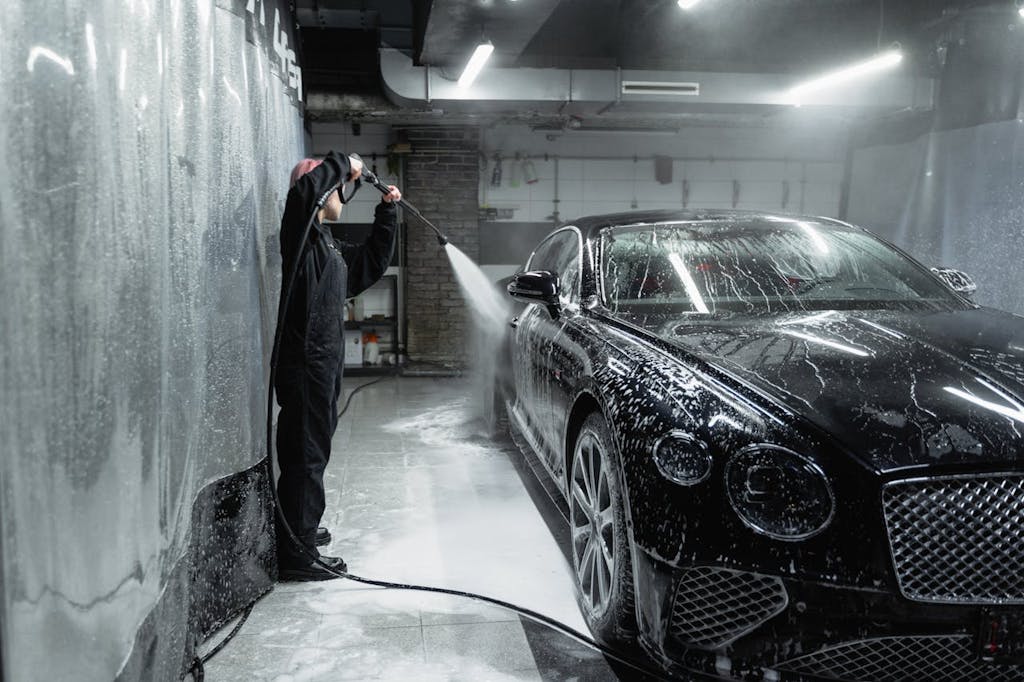Safety is crucial for car washes as they involve chemicals, vehicles, and wet surfaces. In addition, employees and customers move throughout the shop, often at high speeds, emphasizing the need for thorough safety procedures.
Car wash safety is not only a good idea, but it’s also regulated by The Occupational Safety and Health Administration (OSHA), while other aspects are regulated by the Environmental Protection Agency (EPA).
It’s crucial to have comprehensive and documented safety practices to avoid injuries and fines. Using a digital safety inspection platform with robust processes can improve the safety of your car wash. Keep reading to learn best practices for creating a safe environment and essential regulations.
Top Car Wash Safety Tips
Car wash safety doesn’t need to be complicated, although essential. We can divide tips into crucial categories to demonstrate how to create and follow processes to create a safe environment for customers and employees. Keep these categories in mind when creating your digital safety inspection checklists.
Customer Safety
Both self-service car washes and traditional shops can pose risks to customers. Whether they stay in their car or wait inside while your crew washes and details, the below tips will help keep them safe:
- Use visible signage: Post speed limit signs clearly throughout areas in which customers will be driving. Tell customers where to park to drop off cars or if they’ll be vacuuming after a self-service wash. If a conveyor belt is involved, make it clear where to stop and how slowly to approach it. Additionally, make customers aware of any ways their vehicles may be damaged, such as maximum clearance levels.
- Keep all entrances and exits clear: Easy access is both convenient and improves customer safety. Design waiting lanes to be clear of all entryways and exits. You may even designate employees to guide customers if they block any essential areas.
- Create safe waiting areas: Customers should be protected safely from water, chemicals, and machinery. An enclosed and indoor area for customers to wait while their vehicle is being serviced also prevents them from interfering with employees, which can also cause safety issues.
Employee Safety
Providing a safe working environment is essential for any workplace, and car washes create several hazards to your workers. You can help protect employees by following vital safety practices, such as:
- Provide initial and ongoing training: Your workers will be around wet surfaces, machinery, electrical components, and chemicals throughout their workday. They must understand how to avoid injuries during their workday, and training is their best line of defense against injuries. Onboarding should involve in-depth safety training, while all employees should receive ongoing safety training.
- Emphasize avoiding slips, trips, and falls: Car washes are prone to slips, trips, and falls more than most businesses due to frequent wet surfaces, cords, and hoses running throughout the facility. Proper signage in problem areas will provide quick reminders for employees as they work. It’s also worth creating guidelines for shoes, as traction is crucial to walking on wet surfaces.
- Enforce OSHA guidelines and general safety procedures: OSHA has regulations that apply to all workplaces and are crucial for keeping your car wash safe. Additionally, several general safety procedures will benefit your workers, such as understanding chemical storage practices, frequent safety inspections, and maintaining clear walkways. We’ll explore OSHA’s guidelines in more detail below.

Chemical and Mechanical Safety
Car washes have a wide range of machines and chemicals involved in operations. Improper handling or using tools and equipment can create hazards for customers and employees. You may also damage customer vehicles or business equipment. Practice the following safety tips to protect people and property:
- Inspect hoses and pipes often: Leaks can be detrimental to the operation of machinery and create hazards for those around them. Hoses and pipes should be inspected frequently to identify and repair any leaks or breakages that can be identified and repaired before they impact safe working conditions.
- Conduct daily safety inspections of working conditions: The topics we’ve discussed above should be inspected daily with a mobile safety checklist that allows inspectors to document completion or issues. Additionally, it’s important to evaluate machinery daily. Ensure lights are functioning correctly, machinery gauges are in good working order, and monitoring equipment is operational.
- Train staff on proper chemical storage and usage: Many chemicals found throughout car washes create immediate hazards if mishandled. Provide training on proper procedures and enforce any mishandling before it creates issues. Ensure all employees know how to handle every chemical they may interact with throughout the workday.
Carwash Rules and Regulations
Car washes are subject to the same rules and regulations as other businesses but will need to emphasize preventing slip-related injuries and chemical handling. Let’s go over some regulations to be aware of.
- OSHA car wash regulations: OSHA’s workplace safety guidelines cover important and required topics that apply throughout your car wash. Some focus areas for car washes include:
- Prevent wax, cleaning agents, and other chemicals from causing slippery surfaces.
- Be aware of any machinery blocking the worker’s line of sight.
- Manage electrical wires appropriately, especially those operating in wet environments.
- EPA car wash regulations: The EPA may not regulate safety, but the agency does regulate the handling of pollutants you may use. Pollutants are divided into three categories, and fines can be incurred if not appropriately handled. If you have any of these pollutants, research specific handling guidelines:
- Nonconventional: Phosphorus, chlorine, and nitrogen
- Conventional: Grease and oil
- Toxic: Metals and several artificial organic compounds
- Research local and regional regulations: Ensure you’re aware of additional safety and pollution regulations applicable to your city, county, and state. You’ll likely have specific regulations or guidance regarding workplace safety and chemical handling.

Mobile Safety Inspection Software Can Help Keep Your Car Wash Safe
It can be challenging to manage all the moving pieces involved in maintaining a safe environment for employees and customers. However, it’s essential to prevent injuries or exposure to hazardous chemicals for the safety of everyone and the business itself. Fines and penalties can be imposed if violations are discovered.
Mobile safety inspection software equips inspectors with the tools to conduct daily inspections and document results. Inspection results can then be presented to prove compliance with applicable regulations and review to ensure your safety policies are being followed.
Our mobile inspection platform is leading the industry in functionality and flexibility. Your inspectors can upload pictures, videos, and leverage templates to improve inspections. Ready to get started? Sign up with monitorQA today to see how our platform can improve workplace safety.



